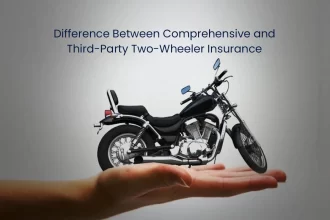Bike insurance is an essential aspect of owning a two-wheeler, ensuring that you’re financially protected in the event of accidents, theft, or damage to your vehicle. One term frequently encountered when purchasing or renewing bike insurance is NCB, or No Claim Bonus. For many bike owners, NCB is a valuable asset that can significantly reduce insurance premiums over time. In this detailed blog post, we will explore what is NCB in bike insurance, how it works, and how you can benefit from it.
We’ll walk you through a step-by-step guide, provide real-life examples, and explain how to check your NCB status. The information provided will help you understand why maintaining a good NCB score is important for long-term savings on your bike insurance.
What is NCB in Bike Insurance?

NCB, or No Claim Bonus, is a discount that bike insurance providers offer to policyholders who do not file any claims during the policy period, typically a year. The longer you go without making a claim, the higher your NCB discount becomes. Over time, the NCB can accumulate and reduce your premium substantially when you renew your policy.
Simply put, the No Claim Bonus rewards policyholders for being safe and cautious on the road. If you’re a responsible driver who doesn’t file any insurance claims, the insurance company will offer you a discount on your renewal premium.
NCB Meaning and Definition
The term No Claim Bonus refers to the reward system that insurance companies use to incentivize safe driving behavior. The more years you go without filing a claim, the greater the bonus you receive. Typically, NCB starts at 20% after the first claim-free year and increases incrementally each year, reaching up to 50% after five consecutive claim-free years.
Key Points:
- NCB is a reward for not making any claims during the policy period.
- It is applicable to own-damage cover, not third-party liability insurance.
- The bonus percentage increases with each consecutive claim-free year, maxing out at 50%.
- NCB can be transferred if you switch insurance providers.
- NCB is linked to the policyholder, not the vehicle, so it can be carried over to a new bike.
Benefits of NCB in Bike Insurance
NCB in bike insurance offers several key benefits for policyholders. Here’s why understanding what is NCB in bike insurance can be advantageous:
- Lower Premiums: The most obvious benefit of NCB is the reduction in premiums. A high NCB percentage can significantly reduce your insurance costs over time.
- Reward for Safe Driving: The NCB system rewards responsible and safe drivers who do not file claims unnecessarily.
- Transferability: NCB can be transferred to a new bike or even to a new insurer, ensuring that your bonus is not wasted.
- Protection Against Rate Hikes: By maintaining a high NCB, you can offset the impact of potential premium rate hikes by insurers.
How Does NCB Work in Bike Insurance?
| Year | Markdown on Insurance Premium |
|---|---|
| First Year | If you do not file any claims during your first year of owning bike insurance, you get a 20% NCB on your next premium. |
| Second Year | By not claiming in the second year, your discount increases to 25%. |
| Third Year | If the third year is also claim-free, you are eligible for a 35% discount on your renewal premium. |
| Fourth Year | Continue to avoid making claims, and your NCB will rise to 45%. |
| Fifth Year | After five years of no claims, you will receive a 50% discount, which is the maximum NCB that you can accrue. |
To fully grasp what is NCB in bike insurance, it’s essential to understand how the No Claim Bonus system operates.
When you purchase an own-damage cover as part of your comprehensive bike insurance, you automatically become eligible for an NCB if you do not make any claims during the policy tenure. For every claim-free year, your NCB increases, leading to progressively higher discounts on your insurance renewal premium.
Let’s break down how this works:
Year-by-Year NCB Calculation:
- First Year: If you do not file any claims during your first year of owning bike insurance, you get a 20% NCB on your next premium.
- Second Year: By not claiming in the second year, your discount increases to 25%.
- Third Year: If the third year is also claim-free, you are eligible for a 35% discount on your renewal premium.
- Fourth Year: Continue to avoid claims, and your NCB will rise to 45%.
- Fifth Year: After five years of no claims, you will receive a 50% discount, which is the maximum NCB that you can accrue.
Example:
Imagine you purchased comprehensive bike insurance with an annual premium of ₹5,000. By the end of the first claim-free year, your premium upon renewal would be reduced by 20%, bringing it down to ₹4,000. Continue this trend for five years, and your renewal premium could be reduced by 50%, meaning you’d only pay ₹2,500.
How to Check NCB in Bike Insurance
Now that you understand the basics of what is NCB in bike insurance, you might be wondering how to check your No Claim Bonus status. Fortunately, checking your NCB is a straightforward process that can be done in a few simple steps:
Step 1: Contact Your Insurance Provider
The first and easiest way to check your NCB is to contact your insurance company directly. Most insurers provide a helpline or online support system where you can inquire about your current NCB status.
Step 2: Review Your Policy Documents
Your bike insurance policy documents should contain information regarding your NCB. You can find it listed on your policy certificate under the NCB section. The percentage or discount applicable to your policy will be mentioned here.
Step 3: Online Insurance Portals
Many insurance providers offer online portals where you can log in to your account and view all the details related to your bike insurance. You can check your current NCB by navigating to the policy summary or renewal section of the portal.
Step 4: Mobile Insurance Apps
If your insurer offers a mobile app, checking your NCB status becomes even easier. Log in to the app and find your policy details, which should display your current NCB discount percentage.
Step 5: Use the Insurance Information Bureau (IIB)
The IIB, an initiative by the Insurance Regulatory and Development Authority of India (IRDAI), maintains a database of insurance policies. You can visit their website and enter your details to check your insurance details, including your NCB status.
Example:
Let’s say you are insured with a major provider like ICICI Lombard or HDFC ERGO. You could either log in to their website or call customer service to ask for your NCB status. Once you have your NCB percentage, it’s easier to calculate how much your premium will be reduced during your next renewal.
Factors Affecting Your NCB
Several factors can impact your NCB status in bike insurance, and it’s important to understand how these elements come into play. Here’s a closer look at what could affect your NCB:
- Filing a Claim: Filing a claim during the policy period will reset your NCB to zero for the next renewal, unless it’s a claim under third-party liability.
- Policy Lapses: If you fail to renew your bike insurance policy on time, you may lose your accumulated NCB. Most insurers offer a grace period for renewal, but once that expires, the NCB is forfeited.
- Switching Insurers: While switching insurers does not affect your NCB, it’s crucial to transfer your NCB certificate to the new provider. Failing to do so can result in the loss of your accrued NCB.
- Vehicle Ownership Transfer: NCB is tied to the policyholder, not the vehicle. If you sell your bike, the NCB stays with you. However, the new owner will not inherit your NCB, and they will have to start from scratch.
How to Retain NCB Even After Making a Claim
One of the most common concerns about what is NCB in bike insurance is whether you lose your NCB if you file a claim. The good news is that some insurance companies offer add-on covers known as NCB Protect. This feature allows you to retain your NCB even if you make one or two claims during the policy period.
NCB Protect Add-On:
The NCB Protect add-on cover is a great way to safeguard your No Claim Bonus. If you opt for this add-on, your NCB will remain intact even if you file a minor claim. However, it’s important to note that this add-on usually covers only a certain number of claims (typically one or two) and does not apply to major claims like theft or total loss.
Example:
You’ve accumulated a 35% NCB on your bike insurance, but you recently had a minor accident and filed a claim. Without the NCB Protect add-on, your NCB would drop to zero, and you’d lose the discount upon renewal. However, with NCB Protect, you can file the claim and still retain your 35% NCB for the next year.
How to Transfer NCB to a New Bike
When you sell your old bike and purchase a new one, you don’t have to start from scratch with your NCB. You can transfer the bonus to your new bike insurance policy, provided you follow the proper procedure.
Step-by-Step Process to Transfer NCB:
- Sell Your Old Bike: Once you’ve sold your bike, inform your insurance provider. You can cancel the existing policy and request an NCB certificate by submitting the buyer/seller agreement (Forms 29 and 30).
- Obtain NCB Certificate: The insurance company will issue an NCB certificate, which serves as proof of your accumulated bonus.
- Buy Insurance for Your New Bike: When you purchase a new bike, present the NCB certificate to the insurer. They will apply the bonus to your new bike insurance policy, reducing your premium accordingly.
- Check NCB Transfer Status: Confirm with the insurance company that your NCB has been successfully transferred to your new bike’s insurance policy.
Example:
Suppose you’ve built up a 40% NCB over the years with your current bike. Now you’re upgrading to a new model. Instead of losing the NCB, you request a certificate from your insurer and transfer the bonus to your new bike’s insurance, resulting in a lower premium for the new vehicle.
How to Calculate NCB in Bike Insurance
Calculating your No Claim Bonus is straightforward once you know the percentage applicable to your policy. Let’s take a look at a simple formula to calculate the NCB on your renewal premium:
Formula:
NCB Discount = Own Damage Premium x NCB Percentage
Example Calculation:
Let’s assume the own-damage premium for your bike insurance is ₹5,000, and you have accumulated a 40% NCB.
NCB Discount = (₹5,000 x 40%) = ₹2,000
This means your renewal premium would be ₹5,000 – ₹2,000 = ₹3,000.
By applying the NCB discount, you save ₹2,000 on your renewal.
Conclusion
Understanding what is NCB in bike insurance can help you save significantly on your premiums and make the most of your bike insurance policy. By maintaining a good driving record, avoiding unnecessary claims, and exploring options like NCB Protect, you can maximize the benefits of your No Claim Bonus. Remember to check your NCB status regularly and transfer it if you switch bikes or insurance providers.
Stay updated on bike insurance and the financial aspects of bike ownership with blogs on AUTOLIVENEWS . Keep reading for the latest car news and bike news in India and for the answer to pressing questions like ‘what is bhp’, ‘what is torque’, and ‘the difference between hatchback, sedan, and SUV’!
If there’s a topic you’d like us to cover, please let us know in the comments below! We’d love to hear your feedback.
Frequently Asked Questions (FAQs)
What happens to my NCB if I make a claim?
If you make a claim, your NCB will reset to zero unless you have the NCB Protect add-on.
Can I transfer my NCB to a new bike?
Yes, NCB is transferable to a new bike as long as you request an NCB certificate from your current insurer.
How much NCB can I accumulate?
The maximum NCB you can accumulate is 50%, which is typically reached after five consecutive claim-free years.
What is the NCB Protect add-on?
The NCB Protect add-on allows you to retain your NCB even after making one or two minor claims during the policy period.
Can I lose my NCB if I switch insurers?
No, you can transfer your NCB when switching insurers as long as you provide the necessary documentation.
Does NCB apply to third-party bike insurance?
No, NCB is applicable only to own-damage cover, not to third-party liability insurance.
How do I check my NCB?
You can check your NCB through your insurance provider, online portals, or by reviewing your policy documents.
Can I accumulate NCB for multiple vehicles?
No, NCB is linked to the policyholder and applies to one vehicle at a time.
What happens to my NCB if I miss renewing my policy on time?
If your policy lapses, you may lose your accumulated NCB unless you renew it within the grace period.
Does NCB apply to add-on covers?
No, NCB applies only to the own-damage portion of your bike insurance and not to add-ons.















